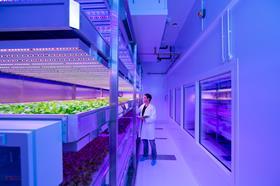
Indoor growing with LEDs may allow salad breeders to bring back high-performing varieties that were not selected for commercial production after past crop trials, a city farming expert has claimed.
Indoor growing facilities have the potential to allow Dutch plant breeder Rijk Zwaan to reinstate certain salad varieties and boost product quality and consistency, said Philips’ programme manager for city farming, Roel Janssen.
“Growing in indoor climate cells means there are no pests, no weather changes, no bugs,” he said. “Everything that was developed by Rijk Zwaan in previous years, but maybe didn’t have enough disease resistance, can potentially be used indoors because here we don’t have disease. We can get better taste, better colouration, faster growth.”
Rijk Zwaan said they had only just begun to screen old varieties, with no varieties yet selected for commercial growing. But Philips has a programme with the plant breeder to screen different varieties to find out which are best for indoor growing and which LED light spectrum they respond to best.
While Janssen accepts that indoor growing will never fully replace traditional salad production outdoors or in polytunnels, he sees big potential for vertical growing in fresh-cut pre-packed salads.
“Indoor growing is the future for growing processed produce like fresh-cut pre-packed salads because you can grow bug-free and with stable nitrates,” he said. “You can predict shelf life, texture and quality because you always get the same product.”
In wholehead lettuce, Janssen believes opportunities are more limited since consumers are already used to wash the product before eating it. “In Europe we could produce a full head of lettuce that you don’t need to wash anymore,” he said, “but people are used to washing it anyway so the added value would probably be limited.”
He added: “There is already a market [for wholehead lettuce that you don’t have to wash] in North America and Asia Pacific, but in countries with really high horticultural standards, like the UK, Netherlands and Scandinavia, I don’t think we would easily replace a greenhouse.”
Produce from indoor farms is typically twice the price, costing around the same as organic produce, however prices could come down in future as LEDs become cheaper and more efficient, and higher-yielding varieties are developed.



